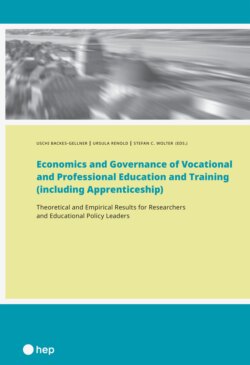Читать книгу Economics and Governance of Vocational and Professional Education and Training (including Apprenticeship) (E-Book) - Uschi Backes-Gellner - Страница 18
На сайте Литреса книга снята с продажи.
2.4 Methodological Problems of Definitions 2.4.1 Problems of Definitions
ОглавлениеVET programs are complex because—in contrast to general education programs—they have to link two social systems, i.e., the education system and the employment system (Rageth & Renold, 2019; Renold et al., 2017; Renold et al., 2015; Eichmann, 1989). Both social systems may have institutional configurations that vary greatly, depending on influencing historical events (i.e., colonialist footprint), socioeconomic conditions, and political schools (i.e., LME, CME) influencing the character of an employment system. It is therefore comprehensible that attempts are being made to find a generally valid definition for VET around which reform leaders can orient themselves.
Some definitions illustrate why this issue is a problem: Vocational education and training refer to the sector of the education system which is aimed at imparting qualifications and normative orientations for occupations in defined functional and positional areas of the employment system. The customary use of the term today excludes academic training courses (Krumme, 2018, para. 1).
The CEDEFOP (2014) notes that “education and training which aims to equip people with knowledge, know-how, skills and/or competences required in particular occupations or more broadly on the labour market” (p. 292). UNEVOC states that “Technical and Vocational Education and Training (TVET) is concerned with the acquisition of knowledge and skills for the world of work” (UNEVOC, 2019). The Swiss Development Cooperation (SDC) presented its definition as follows:
Vocational Skills Development (VSD) encompasses all organized learning processes for the development of technical, social and personal competencies and qualifications that contribute to the sustainable long-term integration of trained people in decent working conditions into the formal or informal economy either on employed or self-employed basis. (SDC, 2016, p. 6[7])
While, in the first definition, the embeddedness of the VET level in the education system is expressed, this is not explicitly the case in the other definitions. Furthermore, it is not clear whether the definitions refer to formal or nonformal education (Carron & Carr-Hill, 1991; Eshach, 2007; DGIZ, 2016).
Such definitions do not help to identify transnational categories (Brockmann et al., 2009), as they are too general. Braun (2006) points out what problem might arise by using such definitions: “So the construct is defined differently broadly in different countries. If important aspects are missing in the comparison for a construct in some countries, the term ‘construct underrepresentation’ is used (Van de Vijver, 2003)” (p. 18). Braun emphasized, by relying on Sartori (1970, 1991), that transferring the social constructs of concepts to another country may lead to conceptual stretching, i.e., a lack of adaptation of the conceptual content to the possibly different context conditions. “To make a concept more generally usable, i.e., to increase the extension, its properties must be reduced, i.e., to reduce the intensity” (Braun, 2006, p. 18[8]). In most policy-driven attempts to precisely define VET, the opposite occurs. Therefore, I conclude that it is difficult to define VET programs or VET systems as a transnational category. These systems are too different with regard to the social constructs of concepts and are most likely founded on different political economy concepts. One has to reduce the complexity of VET to a specific transnational concept so that comparisons have a valid foundation (see example Rageth and Renold, 2019).
Popper and Hansen (2012, 1979) discussed the problem of definition in detail. In their theory of method,[9] Popper and Hansen wrote about the empirical character of everyday language, which is a topic that is of great importance for the study at hand. To speak of “empirical science” would require clear demarcation criteria. As soon as there is a controversial boundary criterion, it is not clearly defined what applies since the different boundary criteria can represent different positions in the controversy. If in science one definition is preferable to another, this is related to its “(theoretical) productiveness” (Popper & Hansen, 2012, p. 401). With the term theoretical productiveness, Popper and Hansen referred to Menger’s (1928) “Dimenionstheorie,” stating that every “definition (…) contains a certain degree of arbitrariness, whose justification can be furnished only by the productiveness of the definition” (p. 76). Popper and Hansen concluded from this assumption that the purpose of a definition is the starting point for a deductive system, where definitions are dogmas and only conclusions produce insights (Popper & Hansen, 2012, 1979). Guaranteeing the empirical character of the concepts and thus having an “empirical” characteristic in common is a minimal requirement for a definition.
The theory of definitional rules would, however, be analogous to logic (the theory of inferential rules) and equivalent to ‘methodology’ (the theory of statement usage); but equivalent at best, and that only if it really manages to accomplish what methodology accomplishes. (Popper & Hansen, 2012, pp. 404–405)
The application of a concept is not determined by definitions but by the use of the concept, which is called its “meaning”. In other words, there are only “working definitions” (Popper & Hansen, 2012, p. 405; German: “Gebrauchsdefinition”; Popper & Hansen, 1979, p. 367). I conclude that the social construct of VET cannot be defined per se. Characteristics must be identified that clearly determine the empirical character and lead the scholar and reader to demarcation criteria that are comparable. The next section is devoted to this topic.
